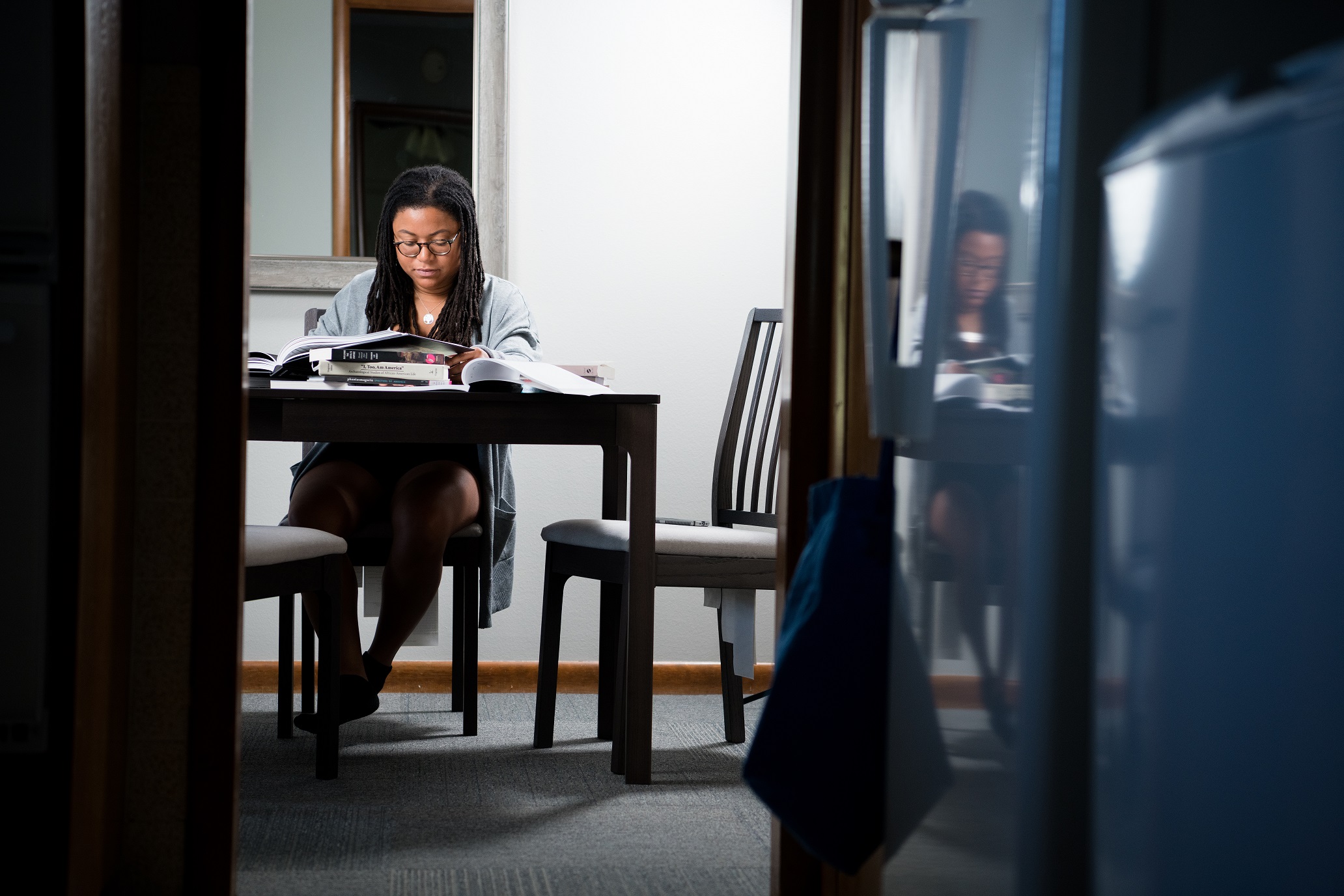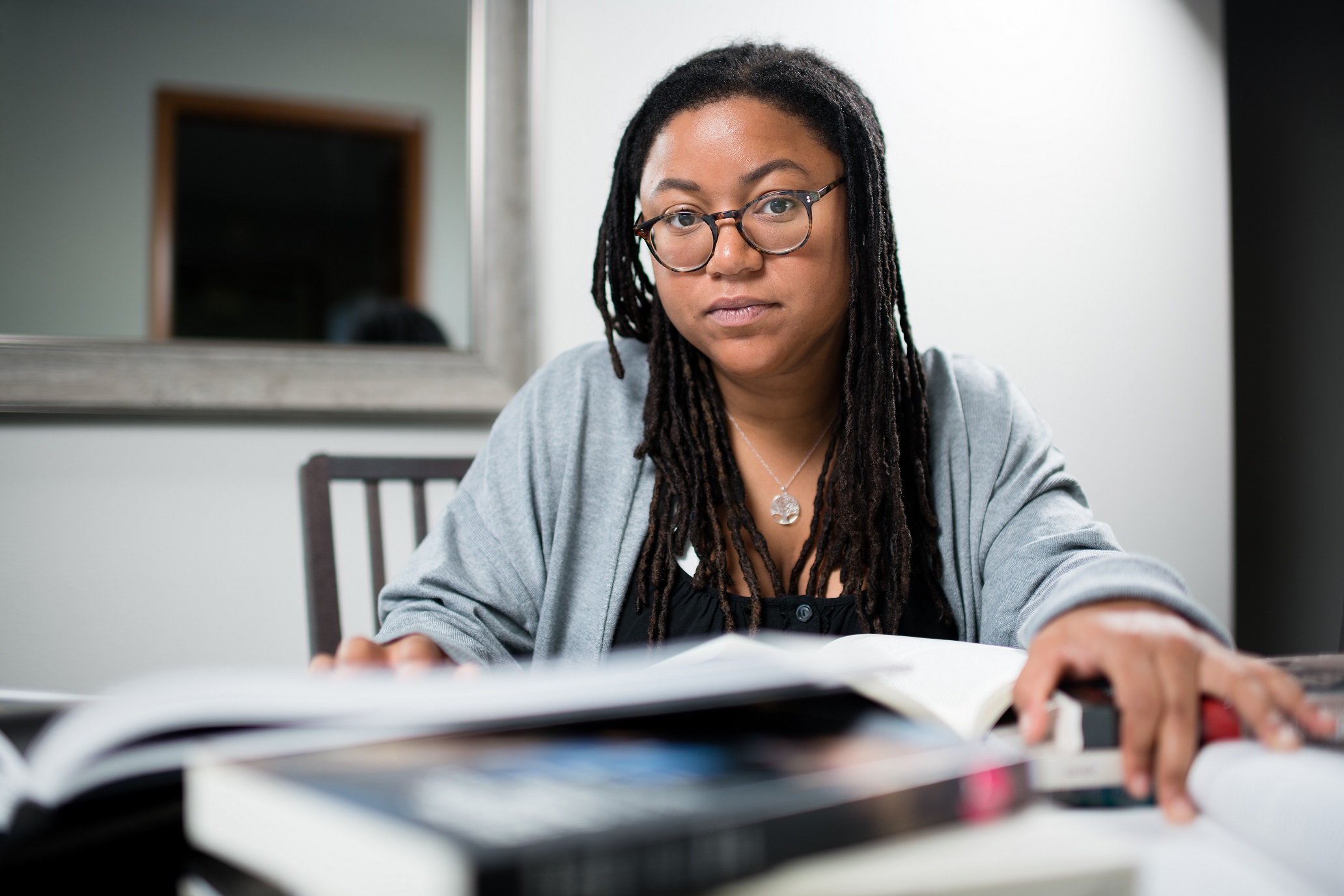A Q&A with Ariel René Jackson
The Momentary’s artist-in-residence program offers artists the opportunity to work on new projects in the middle of the Heartland. In the fall of 2019, artist Ariel René Jackson came to Bentonville, Arkansas to explore relationships with land and memory in her work.
In this conversation with the Momentary, Ariel recounts time spent during her residency researching sundown towns, relationships between people and landscapes in Northwest Arkansas, and how physical markers, such as the Confederate statue that sits in the middle of the Bentonville Square, can manipulate the feeling of a place.
Momentary: Tell us a bit about your art practice. How would you describe your work? What drives you?
Ariel Jackson: I’m interested in the relationship between narrative and meaning in the construction of identity as it relates to land-specific sites. Narratives that develop out of the oral and literary knowledge of marginalized communities drive me in cultivating an intergenerational dialogue. I consider the lexicon of symbols in translating and expanding epistemological relationships to a space or place.
MO: What did you work on during your residency with the Momentary? Was it part of a larger work or research that will lead to another project?
AJ: During my time in Bentonville, I was curious about the relationship between community and site. That site, in this case, became the Confederate monument. The film made during my time in Bentonville has become the foundation in developing a language around weather as a metaphor for how marginalized groups utilize oral archives as a method of measuring the temperature of a space based on sites and historical timelines.

MO: Why Northwest Arkansas? Is there anything about this region that you felt specifically called to before arriving?
AJ: I have cousins who live in Little Rock, Arkansas and my parents stayed in Arkansas for a short time when I was an infant. It feels like Arkansas has been in my rearview window throughout my life and it’s in Arkansas that I was able to pay specific attention to the importance of having a visible Black community who affirms, informs, and shapes how I can navigate sites whose history is riddled with anti-Black symbology and narratives. Allison Glenn, associate curator, contemporary art at Crystal Bridges, suggested that I read Sundown Towns: A Hidden Dimension of American Racism written by sociologist and historian James W. Loewen in 2005. In it, Loewen highlights witness testimonies of various residents of sundown towns throughout the Midwest and in the Ozarks. While the landscape in the Ozark region is beautiful with its rolling hills and steep road inclines, there exists a history made visible through the testimonies of those afflicted by sundown towns, neighborhoods in the United States that practiced exclusion of non-whites by enforcing discriminatory local laws and enacting intimidation via signage and/or physical violence.
MO: After arriving in the region, did anything about your project change? How were you affected by the region?
AJ: About a week in, I shifted my research from text-based to community-based after I came across the Confederate statue that sits in the center of the Bentonville Square. The shift in my focus came in my desire to pay homage to the various perspectives this statue might inform, including how non-white communities navigate spaces that pose themselves as welcoming places. I sought out conversations with locals who knew about the legacy of sundown towns intimately, in or near the area. Bentonville is not a sundown town, but sits near towns that are suspected of having been (or presently) sundown despite increased diversity over recent years. While Bentonville does not share the history of sundown towns, the notion that you can feel when a place doesn’t feel right coupled with a physical marker confirms what was a thought into a belief. Being there for several weeks solidified, for me, the importance of oral data, the accumulation of testimonies that presupposes what areas don’t feel right. I believe this is how non-white communities have avoided overt racism over the past several decades.
While my conversations with locals centered on the statue, I wanted to visually anchor the viewer with analogy in my work. Weather balloons are used to carry instruments that send back information on atmospheric pressure, temperature, humidity, and wind speed. Meteorologists can use this information to make forecasts and predict storms. As it rises into space, it expands until it explodes and falls back to Earth. In front of a camera, I attempted to hide the statue with a weather balloon, slowly raising it up. I like to think through the weather balloon about how individual testimonies collect like layers of soil, letters of survival to make forecasts, and predict unwelcome-ness in landscapes, identifying physical markers, and what they exemplify.
MO: Your work addresses the intersections between identity, landscape, and education. How has landscape and identity in Northwest Arkansas shaped your project?
AJ: I believe that narratives and the symbols that inhabit them shape history for better and for worse. The Confederate statue in the Bentonville square, for some, symbolizes childhood, while the same statue, for others, serves as a reminder of a history of exclusion, violence, and assault. Landscape and narrative are woven in a way that shapes the perception and identity of a place.
MO: Who are your biggest influences? What about their work influences you?
AJ: I love work that explores Black interiority as well as its relationship with external markers. I have been looking to Sondra Perry’s work, specifically in how she generates embodied experience out of immersive environments like in her video and soundscape installation Typhoon coming on(2018). Her ability to zoom in and out of historical sources fascinates me visually and conceptually. She uses contemporary technology as a lens to bring the past into focus.
Torkwase Dyson’s theory of Black Compositional Thought gives language to historical narratives of Black survival and self-liberation, as well, points to contemporary narratives to continue this tradition. Dyson’s exploration of interiority through a practice of abstract painting inspires me. Her work gives physicality to thought processes that point to the landscape where these narratives of self-liberation and survival took place.
Simone Leigh’s three-part installation a particularly elaborate imba yokubikira, or kitchen house, stands locked up while its owners live in diaspora (2016) lives in my mind when I think about the active movement each kitchen hut invites, therefore encouraging a constant formal shift of perception. As you walk around each structure, you are expecting to find a door, the desire leading you to shift your body in a circular manner. The relationship between architecture, body, and site emphasizes the global vastness of the African Diaspora and the desire to go home as an individual and communal desire.
I also think about Fred Wilson’s practice of juxtaposing and reframing historical objects, disrupting and highlighting the meaning we ascribe to objects, therefore interrogating memory. His work continues to inspire as he explores the meaning and materiality of black glass juxtaposed against white walls–there is a relationship between abstraction and representation that resonates with me.

MO: What advice would you give an emerging artist? What have been some of the biggest challenges so far in your career?
AJ: Stay committed to your practice even when you don’t think it’s leading you anywhere with clarity. I’ve sometimes talked myself out of doing a project because I’ve rationalized that it diverged too far from my initial focus. What I’ve come to know is that the artist’s responsibility to their practice is to strike a balance between being aware of their own intuitive decisions while getting out of their own way. I’ve learned and continue to relearn the importance of having faith in the process before dismissing it, and I encourage other artists to find joy in learning and staying committed to curiosity and their practice–you will see how things connect the further along you are down your own respective rabbit hole.
MO: Could you share a bit about your experience in residency at the Momentary and in Northwest Arkansas? Was there anything about the residency that makes it stand out?
AJ: Being in residence at the Momentary gave me more independence than some other residencies. The expectation of this residency is to be proactive, which I found helpful. Knowing that my choices and actions would shape my residency helped me go inward into my practice. It motivated me to explore the ethics and methodology of how my practice would locate and intersect organically with my local Black and Brown community.
MO: Any other thoughts you’d like to share?
AJ: The Momentary is a good start to regenerate cultures that have been historically pushed out of this area. Going forward, there will need to be more equitable, inclusive, and diverse changes to make Bentonville a welcoming place to everyone, especially those involved in the future of Northwest Arkansas’s art scene and its development.
Join us tonight for a screening and panel discussion!
Join us today, June 19, 2020 at 7 p.m. for a screening of Jackson’s film Bentonville Forecast: In the Square, followed by a discussion between the artist, Sharon Killian (Art Ventures/Northwest Arkansas African American Heritage Association), and Sheree Miller (Shame of Bentonville), two of the participants in the film. This talk is presented by Crystal Bridges Museum of American Art and the Momentary, produced in collaboration with Northwest Arkansas African American Heritage Association, and screened on Juneteenth, a day that commemorates the freedom of enslaved African Americans.
Free, with registration.
Streamed simultaneously on Crystal Bridges’ Facebook and the Momentary’s Facebook.



